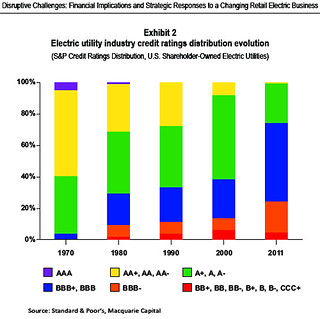 The biggest solar rooftop installation in Georgia?
Not by mighty Georgia Power, not by an EMC, not even by GaSU:
it’s IKEA’s distribution center in Chatham County.
Chatham is also trailing only Atlanta in solar installations in general.
The biggest solar rooftop installation in Georgia?
Not by mighty Georgia Power, not by an EMC, not even by GaSU:
it’s IKEA’s distribution center in Chatham County.
Chatham is also trailing only Atlanta in solar installations in general.
Mary Landers wrote for Savannahnow.com 7 January 2013,
New solar adds to Chatham’s growing inventory,
Just in time for the new year, and for a tax break for the old one,
Consolidated Utilities began producing electricity from solar panels
at its water treatment plant in west Chatham County on the afternoon
of New Year’s Eve.
“When I left on Monday the meter was receiving power,”
said Tony Abbott, president of Consolidated Utilities, a private
local water company.
The 416-panel, 100-kilowatt system is big enough to power about 10
average homes for 25 years, said Julian Smith, of SolarSmith, which
installed the system. At the water treatment site, however, solar
will instead power the blowers that keep the sewage ponds aerated.
The panels occupy previously useless property in a flood zone, Smith
noted.
OK, the
Wiregrass Solar installation at Valdosta’s Mud Creek Wastewater
Treatment Plant is larger, and the Valdosta City Council recently
voted to expand it further.
Go Valdosta!
But what about IKEA?
It’s not the largest solar installation in the county. That honor
still goes to the IKEA distribution center, which in October plugged
in its 1,460-kilowatt solar array on the roof of its distribution
center. That IKEA installation is in fact the largest in the state.
Back in July I mentioned that
IKEA was going to build that array,
and IKEA was building almost as much solar as all of Georgia Power’s
parent Southern Company.
BusinessWire reported 9 Oct 2012
IKEA Plugs-In Georgia’s Largest Private Solar Rooftop Array on Savannah Distribution Center: Surpasses 75% U.S. Solar Presence.
This installation represents the 34th
completed solar project for IKEA in the U.S., with five more
locations underway, making the eventual U.S. solar presence of IKEA
nearly 89% of its U.S. locations, generating with a total 38 MW.
IKEA owns and operates each of its solar PV energy systems atop its
buildings — as opposed to a solar lease or PPA (power purchase
agreement) — and globally has allocated €590 million to
invest in renewable energy, focusing on solar and wind during the
coming three years. This investment reinforces the long-term
commitment of IKEA to sustainability and confidence in photovoltaic
(PV) technology. More than 250,000 solar panels have been installed
on IKEA stores and buildings across the world. The company also owns
and/or operates approximately 110 wind turbines in Europe.
The Savannahnow article mentions something
happening in Chatham County but not so much yet in Lowndes County:
“What’s really going on in Chatham is that lots of homeowners
put solar on their rooftops,” Arora said. “The
excitement exists in Chatham for solar.”
-jsq
 BP must be getting desperate about people catching onto what they did to the Gulf.
A BP video ad has been replaying itself every few minutes beside various
news stories since yesterday, claiming two years after the oil disaster
(“spill” doesn’t describe it) “the beaches are open for everyone to enjoy!”
BP’s website
says “We are helping economic and environmental restoration efforts in the Gulf Coast as part of our ongoing commitment to the region following the Deepwater Horizon accident in 2010”.
Neither the ad nor the website says BP actually cleaned up the oil.
Because they didn’t.
It’s still there, as is the even more toxic “dispersant” Corexit BP
dumped on top of the oil to make it sink.
Both are busily poisoning dolphins, fish, birds, and humans.
BP must be getting desperate about people catching onto what they did to the Gulf.
A BP video ad has been replaying itself every few minutes beside various
news stories since yesterday, claiming two years after the oil disaster
(“spill” doesn’t describe it) “the beaches are open for everyone to enjoy!”
BP’s website
says “We are helping economic and environmental restoration efforts in the Gulf Coast as part of our ongoing commitment to the region following the Deepwater Horizon accident in 2010”.
Neither the ad nor the website says BP actually cleaned up the oil.
Because they didn’t.
It’s still there, as is the even more toxic “dispersant” Corexit BP
dumped on top of the oil to make it sink.
Both are busily poisoning dolphins, fish, birds, and humans.











